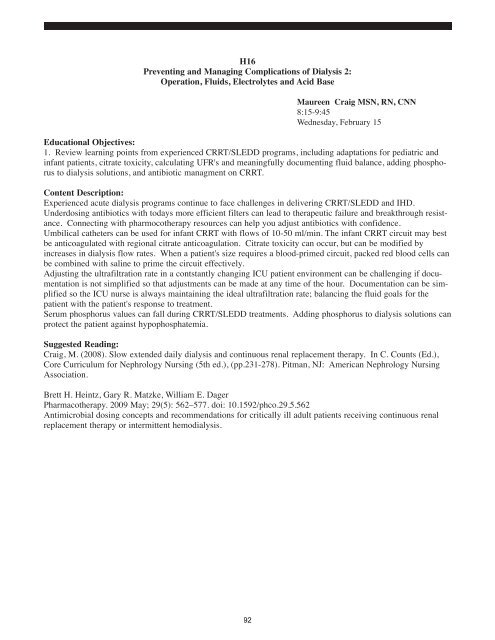ABSTRACTS from 16th International COnference on ... - CRRT Online
ABSTRACTS from 16th International COnference on ... - CRRT Online
ABSTRACTS from 16th International COnference on ... - CRRT Online
Create successful ePaper yourself
Turn your PDF publications into a flip-book with our unique Google optimized e-Paper software.
H16<br />
Preventing and Managing Complicati<strong>on</strong>s of Dialysis 2:<br />
Operati<strong>on</strong>, Fluids, Electrolytes and Acid Base<br />
Maureen Craig MSN, RN, CNN<br />
8:15-9:45<br />
Wednesday, February 15<br />
Educati<strong>on</strong>al Objectives:<br />
1. Review learning points <str<strong>on</strong>g>from</str<strong>on</strong>g> experienced <strong>CRRT</strong>/SLEDD programs, including adaptati<strong>on</strong>s for pediatric and<br />
infant patients, citrate toxicity, calculating UFR's and meaningfully documenting fluid balance, adding phosphorus<br />
to dialysis soluti<strong>on</strong>s, and antibiotic managment <strong>on</strong> <strong>CRRT</strong>.<br />
C<strong>on</strong>tent Descripti<strong>on</strong>:<br />
Experienced acute dialysis programs c<strong>on</strong>tinue to face challenges in delivering <strong>CRRT</strong>/SLEDD and IHD.<br />
Underdosing antibiotics with todays more efficient filters can lead to therapeutic failure and breakthrough resistance.<br />
C<strong>on</strong>necting with pharmocotherapy resources can help you adjust antibiotics with c<strong>on</strong>fidence.<br />
Umbilical catheters can be used for infant <strong>CRRT</strong> with flows of 10-50 ml/min. The infant <strong>CRRT</strong> circuit may best<br />
be anticoagulated with regi<strong>on</strong>al citrate anticoagulati<strong>on</strong>. Citrate toxicity can occur, but can be modified by<br />
increases in dialysis flow rates. When a patient's size requires a blood-primed circuit, packed red blood cells can<br />
be combined with saline to prime the circuit effectively.<br />
Adjusting the ultrafiltrati<strong>on</strong> rate in a c<strong>on</strong>tstantly changing ICU patient envir<strong>on</strong>ment can be challenging if documentati<strong>on</strong><br />
is not simplified so that adjustments can be made at any time of the hour. Documentati<strong>on</strong> can be simplified<br />
so the ICU nurse is always maintaining the ideal ultrafiltrati<strong>on</strong> rate; balancing the fluid goals for the<br />
patient with the patient's resp<strong>on</strong>se to treatment.<br />
Serum phosphorus values can fall during <strong>CRRT</strong>/SLEDD treatments. Adding phosphorus to dialysis soluti<strong>on</strong>s can<br />
protect the patient against hypophosphatemia.<br />
Suggested Reading:<br />
Craig, M. (2008). Slow extended daily dialysis and c<strong>on</strong>tinuous renal replacement therapy. In C. Counts (Ed.),<br />
Core Curriculum for Nephrology Nursing (5th ed.), (pp.231-278). Pitman, NJ: American Nephrology Nursing<br />
Associati<strong>on</strong>.<br />
Brett H. Heintz, Gary R. Matzke, William E. Dager<br />
Pharmacotherapy. 2009 May; 29(5): 562–577. doi: 10.1592/phco.29.5.562<br />
Antimicrobial dosing c<strong>on</strong>cepts and recommendati<strong>on</strong>s for critically ill adult patients receiving c<strong>on</strong>tinuous renal<br />
replacement therapy or intermittent hemodialysis.<br />
92
















